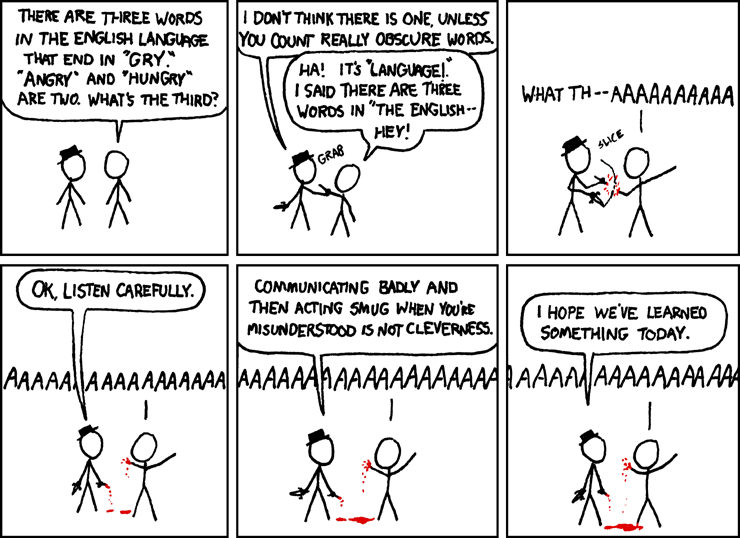A fake Facebook event disguised as a math problem has been one of its top posts for 6 months
-
This kind of problem falls under "communicating badly and acting smug when misunderstood". Use parenthesis and the problem goes away.
This kind of problem falls under “communicating badly and acting smug when misunderstood”.
No it doesn't. It falls under adults forgetting the rules of Maths.
Use parenthesis and the problem goes away
There is no problem, other than adults who have forgotten the rules.
-
You understand that gen x starts around 1965, right? Your stat says they're mostly getting fucked too.
You understand that gen x starts around 1965, right?
10 years earlier than that actually. Johnny Rotten, Billy Idol, etc. The U.S. came late to the party and started using their own definition.
-
For me it's the arguments when there is a parentheses but no operator (otherwise known as implied multiplication) in these baits e.g. 15 + 2(4 - 2)
If you don't know operator orders I have given up long ago, but I have seen a few lengthy discussions about this
For me it’s the arguments when there is a parentheses but no operator (otherwise known as implied multiplication)
No, it's known as Factorised Terms/Products, solved via The Distributive Law, a(b+c)=(ab+ac). "implied multiplication" is a made up rule by people who have forgotten the actual rules, and often they get it wrong (because, having wrongly called it "multiplication", they then wrongly give it the precedence of multiplication, not brackets).
-
Oh yeah, that's a fun one.
Where I live, this would be considered juxtaposition, at least by uni professors and scientific community, so 2(4-2) isn't the same as 2×(4-2), even though on their own they're equal.
This way, equations such as 15/2(4-2) end up with a definite solution.
So,
15/2(4-2) = 3.75
While
15/2×(4-2) = 15
Usually, however, it is obvious even without assuming juxtaposition because you can look at previous operations. Not to mention that it's most common with variables (Eg. "2x/3y").
Where I live, this would be considered juxtaposition
Not just where you live, everywhere, in Maths textbooks. Adults forgetting the rules (and unqualified U.S. teachers not teaching what's in the textbooks) is another matter altogether.
-
I never understood how people couldn’t understand basic PEMDAS/BEDMAS/Whatever-the-fuck-your-country-calls-it.
There's no "whatever-the-fuck-your-country-calls-it", the US is the only country using it, and only up to high school. At least I'm not seeing any papers coming out of the US relying on it so at some point they're dropping it and do what everyone else is doing: Write equations such that you don't need a left-to-right rule to disambiguate things. Also, using multiplication by juxtaposition (2x + 4x^2^).
There’s no “whatever-the-fuck-your-country-calls-it”
Yes there is. BEDMAS, BODMAS, and BIDMAS
the US is the only country using it
No they're not.
at some point they’re dropping it
No, at no point do the order of operations rules ever get dropped
using multiplication by juxtaposition (2x + 4x2)
They're called Terms/Products.
-
"Hey, this is Presh Talwalkar.
Discussion of a brief history of this viral math problem, followed by explanations of common incorrect answers. Ultimately followed by brief discussion on the order of operations, concluding in a final example that equals 11
And that's the answer. Thank you so much for making us one of the best communities on YouTube, where we solve the world's problems, one video at a time."
Hey, this is Presh Talwalkar
Person who has forgotten about The Distributive Law and lied about 1917.
Discussion of a brief history of this viral math problem
Including lying about 1917
Ultimately followed by brief discussion on the order of operations
But forgets about Terms and The Distributive Law.
And that’s the answer
Now watch his other ones, where he screws it up royally. Dude has no idea how to handle brackets. Should be avoided at all costs.
-
So order of operations is hard?
So order of operations is hard?
Not for students it isn't. Adults who've forgotten the rules on the other hand...
-
The issue normally with these "trick" questions is the ambiguous nature of that division sign (not so much a problem here) or people not knowing to just go left to right when all operators are of the same priority. A common mistake is to think division is prioritised above multiplication, when it actually has the same priority. Someone should have included some parenthesis in PEDMAS aka. PE(DM)(AS)

The issue normally with these “trick” questions
There's no "trick" - it's a straight-out test of Maths knowledge.
the ambiguous nature of that division sign
Nothing ambiguous about it. The Term of the left divided by the Term on the right.
A common mistake is to think division is prioritised above multiplication
It's not a mistake. You can do them in any order you want.
when it actually has the same priority
Which means you can do them in any order
-
So let's try out some different prioritization systems.
Left to right:
(((6 * 4) / 2) * 3) / 9 ((24 / 2) * 3) / 9 (12 * 3) / 9 36 / 9 = 4Right to left:
6 * (4 / (2 * (3 / 9))) 6 * (4 / (2 * 0.333...)) 6 * (4 / 0.666...) 6 * 6 = 36Multiplication first:
(6 * 4) / (2 * 3) / 9 24 / 6 / 9Here the path divides again, we can do the left division or right division first.
Left first: (24 / 6) / 9 4 / 9 = 0.444... Right side first: 24 / (6 / 9) 24 / 0.666... = 36And finally division first:
6 * (4 / 2) * (3 / 9) 6 * 2 * 0.333... 12 * 0.333.. = 4It's ambiguous which one of these is correct. Hence the best method we have for "correct" is left to right.
Right to left:
6 * (4 / (2 * (3 / 9)))
Nope! 6 × 4 ÷ 2 × 3 ÷ 9 =4 right to left is 6 ÷ 9 x 3 ÷ 2 × 4 =4. You disobeyed the rule of Left Associativity, and your answer is wrong
Multiplication first: (6 * 4) / (2 * 3) / 9
Also nope. Multiplication first is 6 x 4 x 3 ÷ 2 ÷ 9 =4
Left first: (24 / 6) / 9
Still nope. 6 × 4 x 3 ÷ 2 ÷ 9 =4
Right side first: 24 / (6 / 9)
Still nope. 6 × 4 x 3 ÷ 9 ÷ 2 =4
And finally division first: 6 * (4 / 2) * (3 / 9)
And finally still nope. 6 ÷ 9 ÷ 2 x 4 x 3 =4
Hint: note that I never once added any brackets. You did, hence your multiple wrong answers.
It’s ambiguous which one of these is correct
No it isn't. Only 4 is correct, as I have just shown repeatedly.
Hence the best method we have for “correct” is left to right
It's because students don't make mistakes with signs if you don't change the order. I just showed you can still get the correct answer with different orders, but you have to make sure you obey Left Associativity at every step.
-
I stand corrected
I stand corrected
No, you weren't. Most of their answers were wrong. You were right. See my reply. 4 is the only correct answer, and if you don't get 4 then you did something wrong, as they did repeatedly (kept adding brackets and thus changing the Associativity).
-
Maybe I'm wrong but the way I explain it is until the ambiguity is removed by adding in extra information to make it more specific then all those answers are correct.
"I saw her duck"
Until the author gives me clarity then that sentence has multiple meanings. With math, it doesn't click for people that the equation is incomplete. In an English sentence, ambiguity makes more sense and the common sense approach would be to clarify what the meaning is
until the ambiguity is removed
There isn't any ambiguity.
all those answers are correct
No, only 1 answer is correct, and all the others are wrong.
Until the author gives me clarity then that sentence has multiple meanings. With math
Maths isn't English and doesn't have multiple meanings. It has rules. Obey the rules and you always get the right answer.
it doesn’t click for people that the equation is incomplete.
It isn't incomplete.
-
100% with you. "Left to right" as far as I can tell only exists to make otherwise "unsolvable" problems a kind of official solution. I personally feel like it is a bodge, and I would rather the correct solution for such a problem to be undefined.
100% with you. “Left to right” as far as I can tell only exists to make otherwise “unsolvable” problems a kind of official solution
It's not a rule, it's a convention, and it exists so as to avoid making mistakes with signs, mistakes you made in almost every example you gave where you disobeyed left to right.
-
It's so we don't have to spam brackets everywhere
9+2-1+6-4+7-3+5=
Becomes
((((((9+2)-1)+6)-4)+7)-3)+5=
That's just clutter for no good reason when we can just say if it doesn't have parentheses it's left to right. Having a default evaluation order makes sense and means we only need parentheses when we want to deviate from the norm.
It’s so we don’t have to spam brackets everywhere
No it isn't. The order of operations rules were around for several centuries before we even started using Brackets in Maths.
((((((9+2)-1)+6)-4)+7)-3)+5
It was literally never written like that
we only need parentheses when we want to deviate from the norm
That has always been the case
-
It’s ambiguous which one of these is correct. Hence the best method we have for “correct” is left to right.
The solution accepted anywhere but in the US school system range from "Bloody use parenthesis, then" over "Why is there more than one division in this formula why didn't you re-arrange everything to be less confusing" to "50 Hertz, in base units, are 50s^-1^".
More practically speaking: Ultimately, you'll want to do algebra with these things. If you rely on "left to right" type of precedence rules re-arranging formulas becomes way harder because now you have to contend with that kind of implicit constraint. It makes everything harder for no reason whatsoever so no actual mathematician, or other people using maths in earnest, use that kind of notation.
The solution accepted anywhere but in the US school system range from “Bloody use parenthesis, then” over “Why is there more than one division in this formula why didn’t you re-arrange everything to be less confusing” to “50 Hertz, in base units, are 50s-1”.
No, the solution is learn the rules of Maths. You can find them in Maths textbooks, even in U.S. Maths textbooks.
so no actual mathematician, or other people using maths in earnest, use that kind of notation.
Yes we do, and it's what we teach students to do.
-
Another person already replied using your equation, but I felt the need to reply with a simpler one as well that shows it:
9-1+3=?
Subtraction first:
8+3=11Addition first:
9-4=5Addition first:
9-4=5Nope. Addition first is 9+3-1=12-1=11. You did 9-(1+3), incorrectly adding brackets and changing the answer (thus a wrong answer)
-
Except it does matter. I left some examples for another post with multiplication and division, I'll give you some addition and subtraction to see order matter with those operations as well.
Let's take:
1 + 2 - 3 + 4Addition first:
(1 + 2) - (3 + 4)
3 - 7 = -4Subtraction first:
1 + (2 - 3) + 4
1 + (-1) + 4 = 4Right to left:
1 + (2 - (3 + 4))
1 + (2 - 7)
1 + (-5) = -4Left to right:
((1 + 2) - 3) + 4
(3 - 3) + 4 = 4Edit:
You can argue that, for example, the addition first could be(1 + 2) + (-3 + 4)in which case it does end up as 4, but in my opinion that's another ambiguous case.Except it does matter
No it doesn't. You disobeying the rules and getting lots of wrong answers in your examples doesn't change that.
I left some examples for another post with multiplication and division
Which you did wrong.
I’ll give you some addition and subtraction to see order matter with those operations as well
And I'll show you it doesn't matter when you do it correctly
Subtraction first:
1 + (2 - 3) + 4
1 + (-1) + 4 = 4Nope. Right answer for wrong reason - you only co-incidentally got the answer right. -3+1+2+4=-3+7=4
Right to left:
1 + (2 - (3 + 4))
1 + (2 - 7)
1 + (-5) = -4Nope. 4-3+2+1=1+2+1=3+1=4
Edit: You can argue that, for example, the addition first could be (1 + 2) + (-3 + 4)
Or you could just do it correctly in the first place, always obeying Left Associativity and never adding Brackets
in my opinion that’s another ambiguous case
There aren't ANY ambiguous cases. In every case it's equal to 4. If you didn't get 4, then you made a mistake and got a wrong answer.
-
Oh, but of course the statement changes if you add parentheses. Basically, you’re changing the effective numbers that are being used, because the parentheses act as containers with a given value (you even showed the effective numbers in your examples).
Get this : + 1 - 1 + 1 - 1 + 1 - 1 + 1
You can change the result several times by choosing where you want to put the parentheses. However, the order of operations of same priority inside a container (parentheses) does not change the resulting value of the container.
In the example, there were no parentheses, so no ambiguity (there wouldn’t be any ambiguity with parentheses either, the correct way of calculating would just change), and I don’t think you can add “ambiguity” by adding parentheses — you’re just changing the effective expression to be evaluated.
By the way, this is the reason why I absolutely overuse parentheses in my engineering code. It can be redundant, but at least I am SURE that it is going to follow the order that I wanted.
Oh, but of course the statement changes if you add parentheses
It sure does, but they don't seem to understand that.
-
Another common issue is thinking "parentheses go first" and then beginning by solving the operation beside them (mostly multiplication). The point being that what's inside the parentheses goes first, not what's beside them.
Another common issue is thinking “parentheses go first”
There's no "think" - it's an absolute rule.
then beginning by solving the operation beside them
a(b) isn't an operation - it's a Product. a(b)=(axb) per The Distributive Law.
(mostly multiplication)
NOT Multiplication, a Product/Term.
The point being that what’s inside the parentheses goes first, not what’s beside them
Nope, it's the WHOLE Bracketed Term. a/bxc=ac/b, but a/b( c )=a/(bxc). Inside is only a "rule" in Elementary School, when there isn't ANYTHING next to them (students aren't taught this until High School, in Algebra), and it's not even really a rule then, it's just that there isn't anything ELSE involved in the Brackets step than what is inside (since they're never given anything on the outside).
-
÷ could be a minus sign, see: https://en.wikipedia.org/wiki/Division_sign?wprov=sfla1
÷ could be a minus sign
No it couldn't.
Did you check the reference? It says % can be used as a minus sign, not the obelus. Welcome to what happens when you're next-door neighbour Joe Blow can edit Wikipedia.
-
Yes, it is. The division of a by b in the set of real numbers and the set of rational numbers (which are, de facto, the default sets used in most professions) is defined as the multiplication of a by the multiplicative inverse of b. Alternative definitions are also based on a multiplication.
That's why divisions are called an auxilliary operation.
Yes, it is
No it isn't.
The division of a by b in the set of real numbers and the set of rational numbers (which are, de facto, the default sets used in most professions) is defined as the multiplication of a by the multiplicative inverse of b
No it isn't. The Quotient is defined as the number obtained when you divide the Dividend by the Divisor. Here it is straight out of Euler...

Alternative definitions are also based on a multiplication
Emphasis on "alternative", not actual.








